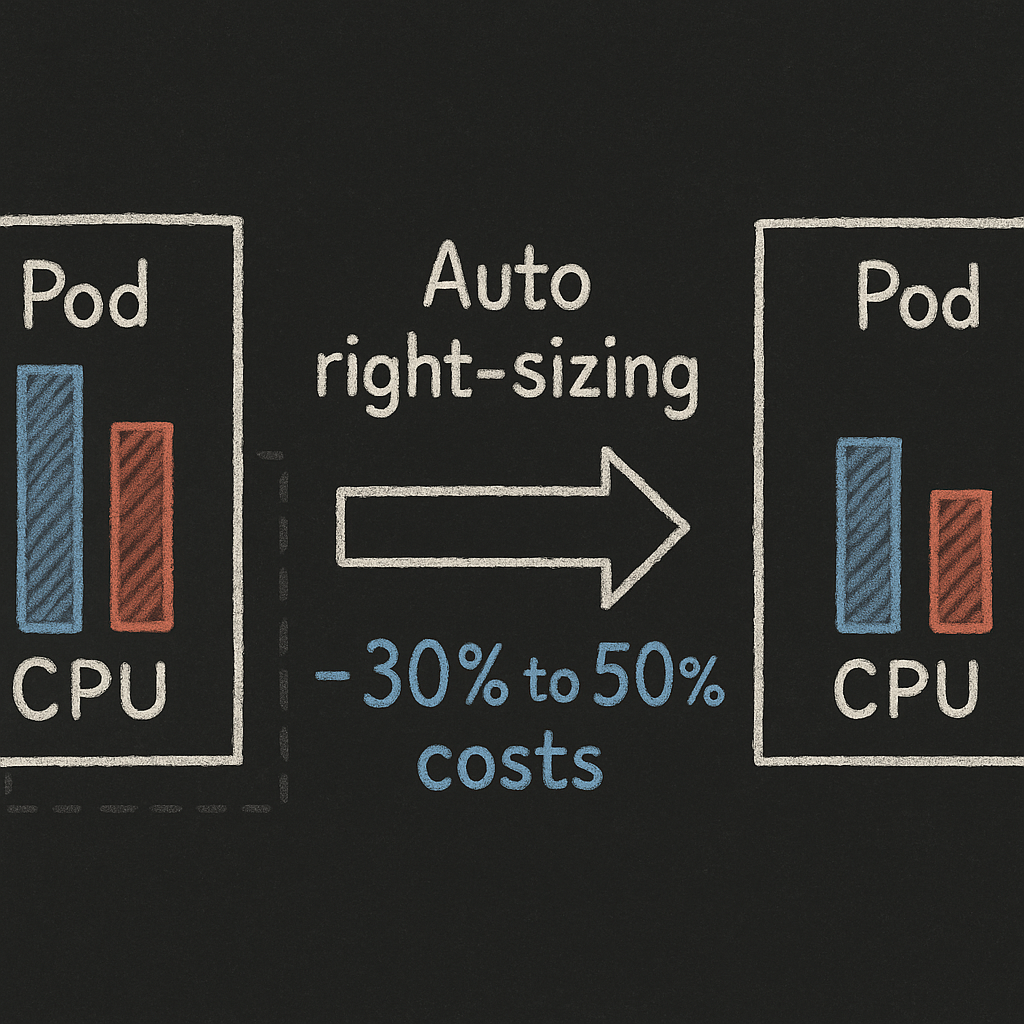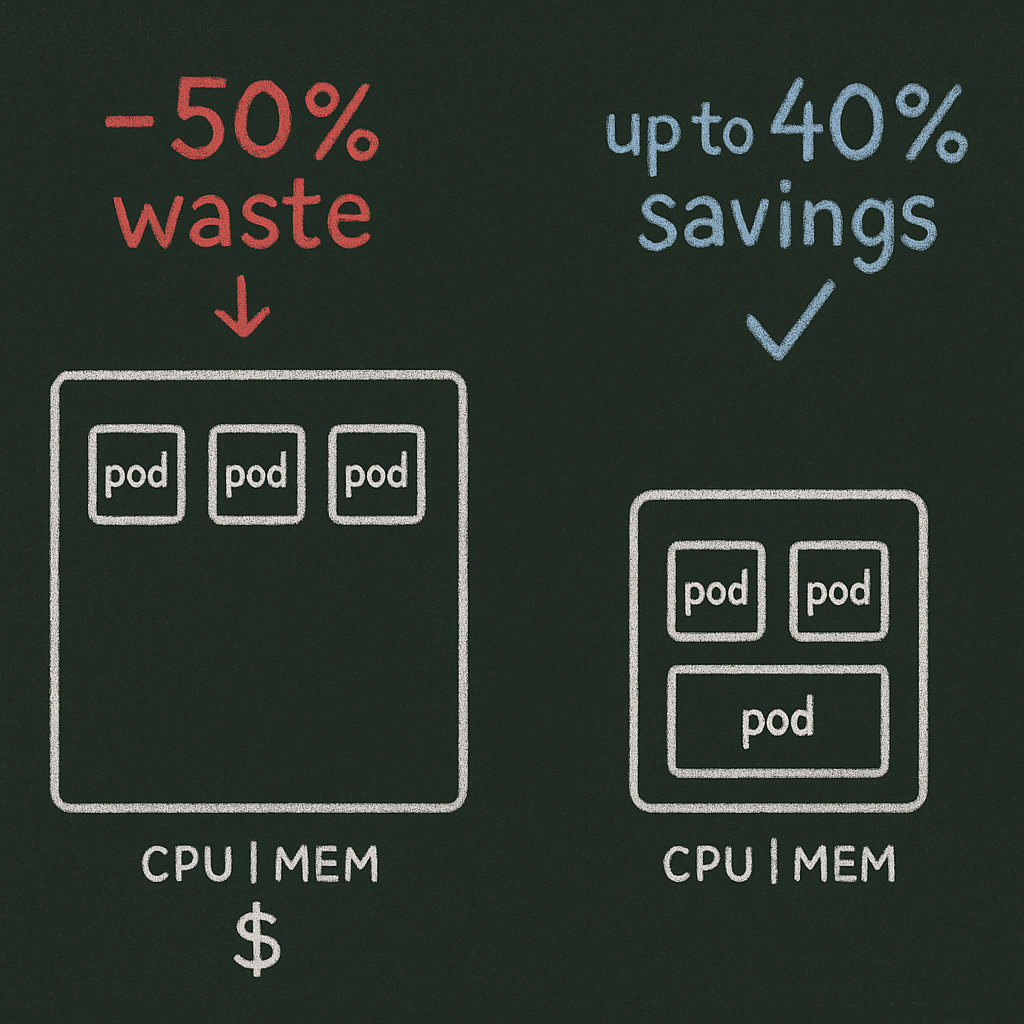Automated Kubernetes Cost Optimization for AWS: Save Up to 40% on Autopilot
Did you know that most organizations waste 30-50% of their Kubernetes spend on over-provisioned resources that pods reserve but don’t actually use? For AWS users running containerized workloads, this represents a massive opportunity to reduce cloud costs without sacrificing performance.
Understanding Kubernetes Cost Challenges on AWS
Kubernetes has revolutionized how we deploy applications, but its cost structure presents unique challenges that traditional cloud cost optimization approaches don’t fully address.
AWS billing data lacks granular insights into pod, namespace, and service-level consumption, making it difficult to understand exactly where your money is going. Safety buffers in resource requests often lead to severely underutilized nodes, while forgotten test environments, zombie pods, and abandoned clusters silently drain budgets. The complexity of determining optimal CPU/memory settings requires continuous analysis, and attribution becomes difficult when multiple teams share clusters.
A software development firm discovered orphaned test clusters costing over $5,000 monthly. After implementing automated detection and termination, they reduced their AWS bill by 22% almost immediately.
Key Strategies for Automated Kubernetes Cost Optimization
1. Dynamic Resource Right-Sizing
Traditional Kubernetes resource management involves educated guesswork. Automated solutions analyze actual usage patterns and adjust resource allocations continuously.
# Example: Optimized resource limits after automated analysisresources: requests: memory: "256Mi" # Down from 1Gi cpu: "100m" # Down from 500m limits: memory: "512Mi" # Down from 2Gi cpu: "200m" # Down from 1000mAccording to AWS EKS best practices documentation, proper resource settings are critical for cost-effective resource utilization, especially when integrated with auto-scaling.
Automated right-sizing tools continuously analyze workload patterns and implement changes during maintenance windows without requiring manual engineering effort, achieving 30-50% reduction in cluster costs.

2. Intelligent Node Auto-Scaling
Basic auto-scaling reacts to current conditions. Intelligent auto-scaling anticipates needs based on historical patterns and workload forecasting.
While AWS’s built-in Kubernetes autoscalers like HPA and VPA are reactive by design (responding to past CPU or memory usage), advanced automation solutions use predictive algorithms to align capacity with actual demand in real-time.
A global e-commerce company implemented predictive node auto-scaling with AWS Spot Instances for batch processing workloads, achieving a 35% cost reduction while maintaining performance during seasonal traffic spikes.
3. Strategic Instance Type Selection
Automation can continuously evaluate and select the most cost-effective instance types based on workload characteristics.
# Example: Automated EKS node group configurationeksctl create nodegroup \ --cluster=production \ --name=spot-workers \ --node-type=m5.large,m5a.large,m5n.large \ --spot \ --nodes-min=2 \ --nodes-max=20Strategic mixing of spot instances for fault-tolerant workloads and reserved instances for predictable applications can reduce compute costs by 60-80% for suitable workloads.
4. Cluster Waste Elimination
Identifying and removing idle resources is tedious manually but perfect for automation.
Common waste sources that automation can eliminate include orphaned volumes and snapshots, forgotten test/staging clusters, over-allocated persistent storage, unnecessarily high IOPS/throughput settings, and duplicate or redundant resources.
Elimination of unused Kubernetes resources can account for up to 15% of total cloud spending.
5. Real-Time Monitoring and Alerting
Combining kubernetes cost monitoring with performance data is essential for optimization.
Tools like Amazon CloudWatch Container Metrics provide resource usage metrics for EKS clusters, which can be visualized alongside cost data in Datadog and Grafana for comprehensive visibility.
Hykell’s Automated Kubernetes Cost Optimization for AWS
Hykell’s automated solution for Kubernetes on AWS addresses all aspects of container cost optimization while requiring minimal engineering effort.
How Automation Drives 40% Cost Reduction
Unlike manual approaches or recommendation tools, automation implements changes continuously. Hykell’s full-stack integration optimizes both Kubernetes resources and underlying AWS infrastructure, with built-in safeguards to ensure cost savings never impact application performance. The set-and-forget solution operates without consuming internal engineering resources.

A SaaS company running microservices on EKS achieved a 42% reduction in overall Kubernetes costs through Hykell’s comprehensive optimization strategy that combined automated pod resource right-sizing, intelligent node scaling with mixed instance types, automated reserved instance management for predictable workloads, Spot Instance integration for non-critical services, and unused resource cleanup.
Comparing Manual vs. Automated Kubernetes Cost Optimization
| Aspect | Manual Approach | Automated Approach with Hykell |
|---|---|---|
| Effort Required | 10-15% of engineering time | Near-zero ongoing effort |
| Optimization Frequency | Monthly/quarterly reviews | Continuous, real-time adjustments |
| Cost Reduction Potential | 15-20% | Up to 40% |
| Performance Impact | Risk of under-provisioning | Guaranteed performance protection |
| Implementation Time | Weeks/months | Days |
| Governance | Manual policy enforcement | Automated policy compliance |
Comparing manual vs automated cloud cost strategies shows that automation consistently delivers superior results with less effort.
Implementation Roadmap: Getting Started with Automated Optimization
Starting with automated Kubernetes cost optimization follows a clear path. First, measure current Kubernetes spend and utilization patterns to establish a baseline. Then implement quick wins by addressing obvious waste and overprovisioning. Next, deploy automated cost optimization tools with guardrails, followed by establishing dashboards for tracking savings and performance. Finally, review and adjust optimization parameters quarterly for continuous refinement.
Beyond Cost Savings: Additional Benefits of Automation
While cost reduction is the primary goal, automated Kubernetes optimization delivers additional benefits. Right-sized clusters handle traffic spikes more efficiently, improving scalability. Properly allocated resources reduce throttling and out-of-memory errors, enhancing performance. Lower resource consumption reduces carbon footprint, creating a positive environmental impact. Teams can focus on innovation rather than cost management, and stabilized cloud costs enable better financial planning.
Organizations implementing automated cloud cost governance report not just savings but improved operational efficiency across the board.
Transform Kubernetes Costs from Burden to Advantage
Properly optimized Kubernetes clusters on AWS can reduce aws cloud cost by up to 40% without compromising performance. While manual optimization is possible, automation delivers superior results with minimal engineering effort.
By implementing automated Kubernetes cost optimization, AWS users can redirect engineering resources from cost management to innovation while achieving sustainable savings. With Hykell’s approach, you only pay a portion of the actual savings achieved—making it a risk-free way to transform your cloud economics.
Ready to see how much you could save? Hykell offers a free assessment to identify potential Kubernetes cost savings on AWS, with implementation in as little as a week.
